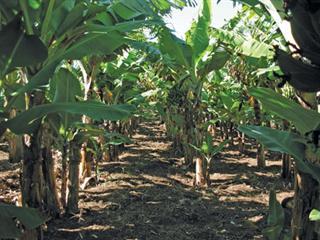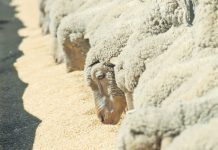
What are the barriers preventing subsistence and emerging farmers from engaging in the mainstream economy? This is a question posed by researchers from the Institute of Natural Resources (INR) in Petermaritzburg, who are seeking to enhance the output of smallholder producers.
As part of their project, the researchers are investigating the production systems used on small-scale banana farms in the villages of Seaview, Marina and Vulindlela in Bizana in the Eastern Cape. These vary from a few trees in a backyard to well laid-out orchards.
The bananas grown by these producers are ripened naturally, and are just as firm and tasty as store-bought bananas. However, they are not handled as carefully, which results in a few blemishes. And more significantly, both the bunches and the bananas tend to be smaller than the commercial varieties.
This smaller size is due to several factors. Firstly, the producers tend to grow their fruit on a limited area, so they maximise the use of space by planting as many trees as possible, which reduces the size of the bunches and bananas.
Secondly, the smallholders cannot afford fertiliser, and rely instead on compost and chicken litter.
Better methods
The INR researchers, working closely with Lima Rural Development Foundation, the Eastern Cape agriculture department, and commercial banana growers, are experimenting with ways to work within these constraints, yet improve yields. A trial was initiated in November 2011 with the help of local commercial producer Quentin Elliot. The aim is to help local farmers understand the importance of:
- New hybridised stock over old, locally procured stock. Commercial farmers generally replace a percentage of their crop every 10 years, but this has not happened in the study area.
- Soil fertility management. The trial compares crops grown with and without fertiliser.
- Mulching. Most commercial banana farmers use irrigation, while the smallholder production is rainfed. Mulching is thus a logical alternative to keep the ground moist, and the trial is seeking to establish its effectiveness.
Field visits revealed that several farmers were applying these methods to some extent. Zakhele Ntlese from Seaview makes compost from weeds, old leaves and chicken litter, while Timoty Khandayo uses grass as mulch on his land in Vulindlela.
Practicality
During the trial, the reseachers will monitor the yield, size and quality of the bananas. While it is obvious that the plots combining new hybridised stock, fertiliser and mulching will provide the highest yields, the researchers realise that smallholders cannot afford expensive inputs.
A cost and benefit analysis will therefore be conducted to establish the most cost-effective production techniques. Although the results are not yet in, the study has already benefited smallholders by giving them the opportunity to engage with commercial farmers.
Contact Jon McCosh at the Institute of Natural Resources on 033 346 0796.












